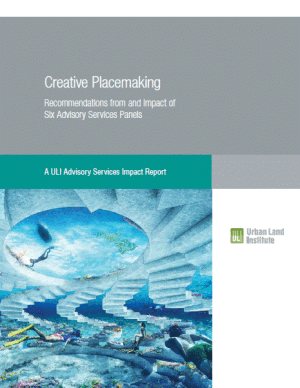A new ULI report explores the social, environmental, and economic benefits of creative placemaking, along with successful case studies in the United States.
Creative Placemaking: Recommendations from and Impact of Six Advisory Services Panels presents the business case and process for creative placemaking—an innovation that brings art and culture to the early design process of a real estate development project.
Using six primary case studies from ULI’s Advisory Services program, the report offers unique insights into how creative placemaking can spark a cultural rebirth in real estate projects, revitalize communities, and boost returns on investment for developers. It also provides best practices about how to plan, finance, implement, and manage projects.
“Creative placemaking isn’t just an aesthetic choice—it’s a vital tool for urban development and renewal,” says Tom Eitler, senior vice president of Advisory Services at ULI. “As a marketing tool that demonstrates the strength of the ULI Advisory Services process and an educational aid that highlights the economic, social, and environmental value of creative placemaking, this report represents a huge step forward for ULI in achieving our mission. We’re proud to provide this guidance to our members and the real estate community.”
The report offers six Advisory Services panels (ASPs) convened during the past five years as case studies illustrating successful creative placemaking across diverse project types in U.S. cities of various sizes, economic conditions, and geographic locations:
- Downtown South, Raleigh, North Carolina—A planned $2 billion mixed-use residential, office, and retail complex eventually to be anchored by a 20,000-seat sports and entertainment center, this project represents new development surrounded by two racially diverse and culturally rich neighborhoods. Developers have pursued enhancements like restoration of natural water features and foot paths to facilitate accessibility, along with art installations that celebrate the neighborhood’s rich history and culture.
- Shaw University, Raleigh, North Carolina—The first Historically Black College and University in the South, Shaw has been challenged by declining student enrollment and worn historic buildings. In response, the university has sought to transform its campus into an open, community-focused space. As part of that effort, Shaw partnered with the city to create a Strollway stop in front of the campus that will bring new people to its doorstep. In addition to historic preservation initiatives underway, it also plans to develop a campus cultural heritage trail.
- Second Avenue, Nashville—A 2020 bombing damaged several Victorian buildings along this historic street. The city responded with a commitment to restore them to their past splendor. It plans to create a lighted mural opposite the bombed site to celebrate the street’s rich history. Other amenities include outdoor dining, curated retail, and entertainment in a new corridor connecting the river and First and Second Avenues.
- Charity Hospital, New Orleans—Shuttered after the 2005 devastation of Hurricane Katrina, this hospital had served the citizens of New Orleans for over six decades. Charity implemented several creative placemaking recommendations in its recovery, including a move to redevelop into a $300 million mixed-use project of residential, retail, office, research, and indoor and outdoor public spaces and a medical museum.
- Stormwater Management and Climate Adaptation, Miami Beach—Facing rising sea levels due to climate change, Miami Beach is pursuing a resilience plan that maintains its reputation as an art-adorned tourist attraction. Program leaders have integrated creative placemaking into resilience projects using permanent and temporary art installations, including an underwater reef sculpture made of materials that foster coral growth and enhance coastal resilience.
- Christiansted, St. Croix, U.S. Virgin Islands — Located between the Caribbean Sea and the Atlantic Ocean, St. Croix is vulnerable to extreme weather. The town suffered over $10 billion in losses from two back-to-back category 5 hurricanes in 2017. As part of its restoration, Croix is expanding its famous market square to involve community development and social transformation through the arts, such as culturally themed after-school programs and Afro-Caribbean community forums.
“The ULI case studies in our report are models for how creative placemaking can revitalize and transform diverse communities,” says Juanita Hardy, the report author and consultant to ULI on Creative Placemaking. “In urban areas that are changing due to gentrification, it’s an invaluable tool for preserving history and culture. In communities threatened by environmental change, it inspires creative solutions that promote resilience.
“Artists bring fresh approaches to problem solving. They are creators, innovators, people connectors, and more. Engaging artists early in the design process can be crucial for solving difficult land use challenges.”
The full Creative Placemaking: Recommendations from and Impact of Six Advisory Services Panels report is available on ULI’s Knowledge Finder platform.


![Western Plaza Improvements [1].jpg](https://cdn-ul.uli.org/dims4/default/15205ec/2147483647/strip/true/crop/1919x1078+0+0/resize/500x281!/quality/90/?url=https%3A%2F%2Fk2-prod-uli.s3.us-east-1.amazonaws.com%2Fbrightspot%2Fb4%2Ffa%2F5da7da1e442091ea01b5d8724354%2Fwestern-plaza-improvements-1.jpg)


